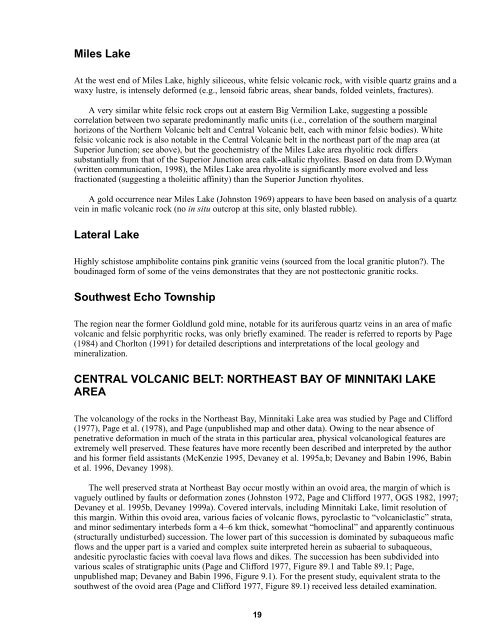Regional Geology, Sioux Lookout Orogenic Belt - Geology Ontario
Regional Geology, Sioux Lookout Orogenic Belt - Geology Ontario
Regional Geology, Sioux Lookout Orogenic Belt - Geology Ontario
Create successful ePaper yourself
Turn your PDF publications into a flip-book with our unique Google optimized e-Paper software.
Miles Lake<br />
At the west end of Miles Lake, highly siliceous, white felsic volcanic rock, with visible quartz grains and a<br />
waxy lustre, is intensely deformed (e.g., lensoid fabric areas, shear bands, folded veinlets, fractures).<br />
A very similar white felsic rock crops out at eastern Big Vermilion Lake, suggesting a possible<br />
correlation between two separate predominantly mafic units (i.e., correlation of the southern marginal<br />
horizons of the Northern Volcanic belt and Central Volcanic belt, each with minor felsic bodies). White<br />
felsic volcanic rock is also notable in the Central Volcanic belt in the northeast part of the map area (at<br />
Superior Junction; see above), but the geochemistry of the Miles Lake area rhyolitic rock differs<br />
substantially from that of the Superior Junction area calk--alkalic rhyolites. Based on data from D.Wyman<br />
(written communication, 1998), the Miles Lake area rhyolite is significantly more evolved and less<br />
fractionated (suggesting a tholeiitic affinity) than the Superior Junction rhyolites.<br />
A gold occurrence near Miles Lake (Johnston 1969) appears to have been based on analysis of a quartz<br />
vein in mafic volcanic rock (no in situ outcrop at this site, only blasted rubble).<br />
Lateral Lake<br />
Highly schistose amphibolite contains pink granitic veins (sourced from the local granitic pluton?). The<br />
boudinaged form of some of the veins demonstrates that they are not posttectonic granitic rocks.<br />
Southwest Echo Township<br />
The region near the former Goldlund gold mine, notable for its auriferous quartz veins in an area of mafic<br />
volcanic and felsic porphyritic rocks, was only briefly examined. The reader is referred to reports by Page<br />
(1984) and Chorlton (1991) for detailed descriptions and interpretations of the local geology and<br />
mineralization.<br />
CENTRAL VOLCANIC BELT: NORTHEAST BAY OF MINNITAKI LAKE<br />
AREA<br />
The volcanology of the rocks in the Northeast Bay, Minnitaki Lake area was studied by Page and Clifford<br />
(1977), Page et al. (1978), and Page (unpublished map and other data). Owing to the near absence of<br />
penetrative deformation in much of the strata in this particular area, physical volcanological features are<br />
extremely well preserved. These features have more recently been described and interpreted by the author<br />
and his former field assistants (McKenzie 1995, Devaney et al. 1995a,b; Devaney and Babin 1996, Babin<br />
et al. 1996, Devaney 1998).<br />
The well preserved strata at Northeast Bay occur mostly within an ovoid area, the margin of which is<br />
vaguely outlined by faults or deformation zones (Johnston 1972, Page and Clifford 1977, OGS 1982, 1997;<br />
Devaney et al. 1995b, Devaney 1999a). Covered intervals, including Minnitaki Lake, limit resolution of<br />
this margin. Within this ovoid area, various facies of volcanic flows, pyroclastic to “volcaniclastic” strata,<br />
and minor sedimentary interbeds form a 4–6 km thick, somewhat “homoclinal” and apparently continuous<br />
(structurally undisturbed) succession. The lower part of this succession is dominated by subaqueous mafic<br />
flows and the upper part is a varied and complex suite interpreted herein as subaerial to subaqueous,<br />
andesitic pyroclastic facies with coeval lava flows and dikes. The succession has been subdivided into<br />
various scales of stratigraphic units (Page and Clifford 1977, Figure 89.1 and Table 89.1; Page,<br />
unpublished map; Devaney and Babin 1996, Figure 9.1). For the present study, equivalent strata to the<br />
southwest of the ovoid area (Page and Clifford 1977, Figure 89.1) received less detailed examination.<br />
19

















